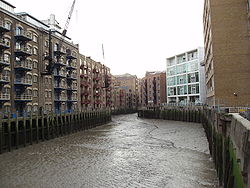St Saviour's Dock is a small dock on the south bank of the River Thames, London, 420 metres east of Tower Bridge and forms the eastern end of the picturesque and historic embankment that starts at Tower Bridge known as Shad Thames. The other side of the Dock is Jacob's Island.


Geography
The Thames is highly tidal at this point and the intertidal range within the dock is substantial, with a rise and fall of four metres since the construction of a system of winter flow-regulating locks and weirs on the River Thames culminating in Teddington Lock and of the Thames Barrier. During tidal surges the water level has risen just above pavement level of adjacent buildings on Shad Thames and Mill Street. The rectangular inlet opens to the river 420 metres east of Tower Bridge.[1]
St Saviour's Dock is the point where the River Neckinger enters the Thames, a subterranean river that rises in the south of Southwark, near Walworth[citation needed] and flows to the Thames underground.[2]
History
A community of Cluniac monks resided at Bermondsey Abbey close to the site from 1082 onwards. The community began the development of the Bermondsey area, cultivating the land and embanking the riverside into a Priory Close spanning 140 acres of meadow and digging dykes. They turned the adjacent tidal inlet at the mouth of the River Neckinger into the priory's dock, and named it Saint Saviour's Dock after their abbey's patron. This provided a safe landing for Bishops and goods below the traditional first crossing, the congested stone arches of London Bridge.[2] According to the Winchester Episcopal Register, the Bishop of Winchester when returning from abroad was expected to land at Bermondsey shores.[3]
John Stow, a 16th-century English historian and antiquarian had the following to say about the area,
"In the south end whereof was sometime a priory or abbey of St. Saviour, called Bermond's Eye in Southwark, founded by Alwin Childe, a citizen of London, in the year 1081."
St Saviour's in the Arts
Charles Dickens set portions of his novel Oliver Twist in the area of Shad Thames, at a time when it was an area of notorious poverty known as Jacob's Island. In Oliver Twist, he set Bill Sikes's den at the east of Shad Thames in Oliver Twist, in the buildings adjacent to St Saviour's Dock. It is here that Sykes falls from a roof and dies in the mud, probably of St Saviour's Dock.
Dickens gives us a vivid description of what this unsavoury place must have looked like at the time of the novel,
- ". . . crazy wooden galleries common to the backs of half a dozen houses, with holes from which to look upon the slime beneath; windows, broken and patched, with poles thrust out, on which to dry the linen that is never there; rooms so small, so filthy, so confined, that the air would seem to be too tainted even for the dirt and squalor which they shelter; wooden chambers thrusting themselves out above the mud and threatening to fall into it - as some have done; dirt-besmeared walls and decaying foundations, every repulsive lineament of poverty, every loathsome indication of filth, rot, and garbage: all these ornament the banks of Jacob's Island."
St Saviour's dock was also featured in the 2002 videogame The Getaway.
References
- ^ Grid reference Finder measurement tools
- ^ a b H.E. Malden (editor) (1912). "Parishes: Bermondsey". A History of the County of Surrey: Volume 4. Institute of Historical Research. Retrieved 22 November 2012.
{{cite web}}:|author=has generic name (help) - ^ Winchester Episcopal Register, Pontoise, fol. 155a